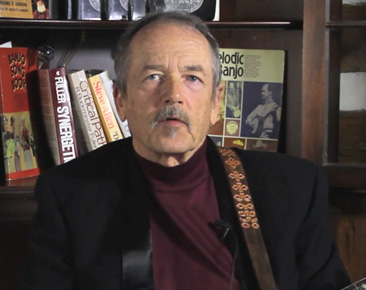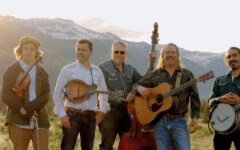
Produced and directed by Bud Bennett, Radford University
Conceived, written and hosted by Butch Robins
 If you like bluegrass history, you will positively “waller” in this video series!
If you like bluegrass history, you will positively “waller” in this video series!
Banjoist Butch Robins was a highly regarded Blue Grass Boy with Bill Monroe. It’s sometimes forgotten he also played electric bass with the early NewGrass Revival, too. Beginning in 1977 Butch performed for 4 years in one of the best regarded versions of the Blue Grass Boys, featuring Kenny Baker, Wayne Lewis and Randy Davis.
If you’ve never had the pleasure of a conversation with Butch, you should understand that he has a lot on his mind and he doesn’t mind sharing. In 2003 he published What I Know ‘Bout What I Know about his life as bluegrass musician, and his fascination… no…obsession with Bill Monroe. It was informative, and blunt. But apparently he had a lot more yet to say!
Radford University in Radford VA, southwest of Roanoke, is along US Rt 11 or the old Lee Highway. Radford University is one of Virginia’s eight doctoral degree granting public universities. Butch makes his home in the area.
Bud Bennett from Radford University has often enjoyed Butches’ discourses on bluegrass music. Butch has wanted to get his musings captured on video. In 2013 they got together and made it happen. Bennett’s videography team rented a nearby cabin, designed a simple, appropriate set, and let ‘er roll. The lightly edited result is Butch’s outspoken perspective on the birth and growth of blue grass (two words) music, that is, BILL MONROE’s art form.
In the Introduction Butch promises to give you his views point blank, and he sure does!
Part 1 is the early history of music and the Monroes up to 1945. There’s some real meat here, right off quick.
Part 2 covers the birth of Bill Monroe’s perfected blue grass in 1945, through its explosive growth to its little-remembered near collapse by 1959. Butch straightforwardly uncovers some of the “dark side” of Monroe’s career.
Part 3 reviews 1959-77 when Monroe’s career was rejuvenated by the folk boom, Ralph Rinzler, the young Yankee Blue Grass Boys, and Carlton Haney’s creation of the bluegrass festival and the “Blue Grass Sto-ry”.
Part 4 surveying 1977 – 21st Century naturally enough covers Butch’s inside view of Bill’s music, also Butch’s problems “letting go,” and his eventual happier relationship with the old man. Butch takes two riveting sidetracks explaining blue grass music timing. Not to be missed.
I became aware of this series from Bud Bennett’s announcement last week on the Banjo Hangout. I spent hours “binge-ing” late into the night watching on my computer. I couldn’t tear myself away. Even after all these years, there’s still lots of bluegrass history to be brought to light. Butch references Richard D. Smith’s book Can’t You Hear Me Calling. If that book revealed some surprises, Butch shows that it barely scratched the surface. Yet, a few times Butch pulls his punches, saying “I’m not going there.”
There are “wow!” moments. There are insights into the peccadillos of many historical figures. But I was surprised how deeply moved I was when Butch let his emotions show. His heart is right out on his sleeve.
Butch picks a little banjo, but this isn’t a performance video. There are many illustrative fifteen-second clips of historic recordings sprinkled throughout, supported by still photographs.
This video series is highly recommended if you’re interested in Butch Robins, Bill Monroe, the history of bluegrass and those who make it, music theory, trivia, or even “art” as a concept.
And it’s free.
Kudos to Butch Robins, Bud Bennett and the Radford University team for making this fascinating concept real.







